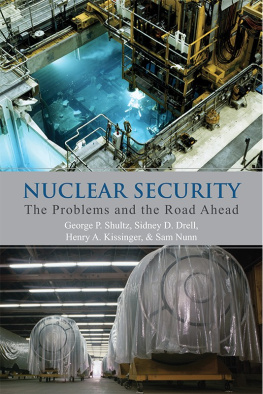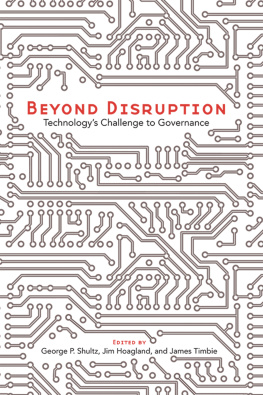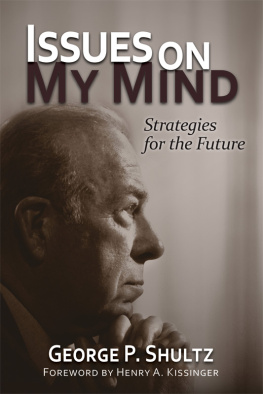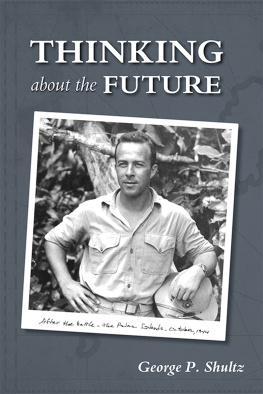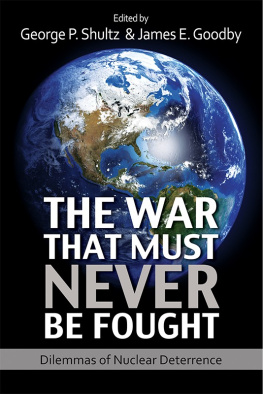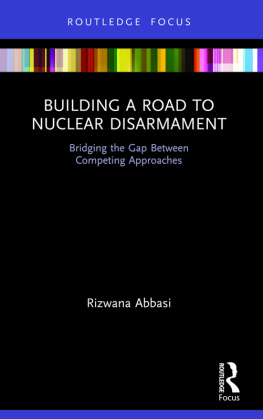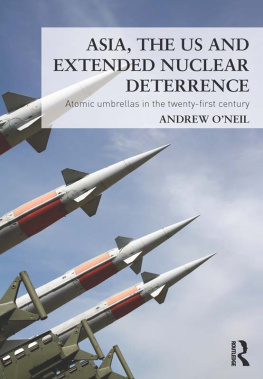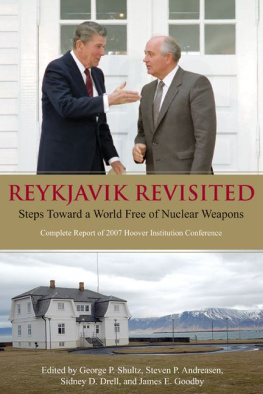Nuclear Security
The Hoover Institution gratefully acknowledges the following individuals and foundations for their significant support of this publication and the conference on which this book is based:
T HOMAS AND B ARBARA S TEPHENSON
T HE W ILLIAM AND F LORA H EWLETT F OUNDATION
P RESTON AND C AROLYN B UTCHER
J OHN AND A NN D OERR
T HE K ORET F OUNDATION
T HE M ARY J O AND D ICK K OVACEVICH F AMILY F OUNDATION
W ILLIAM AND S USAN O BERNDORF
P AUL AND S ANDRA O TELLINI
T HE T HOMAS AND S TACEY S IEBEL F OUNDATION
George P. Shultz
Sidney D. Drell
Henry A. Kissinger
Sam Nunn
H O O V E R I N S T I T U T I O N P R E S S
STANFORD UNIVERSITY STANFORD, CALIFORNIA
The Hoover Institution on War, Revolution and Peace, founded at Stanford University in 1919 by Herbert Hoover, who went on to become the thirty-first president of the United States, is an interdisciplinary research center for advanced study on domestic and international affairs. The views expressed in its publications are entirely those of the authors and do not necessarily reflect the views of the staff, officers, or Board of Overseers of the Hoover Institution.
www.hoover.org
Hoover Institution Press Publication No. 654
Hoover Institution at Leland Stanford Junior University,
Stanford, California 94305-6010
Copyright 2014 by the Board of Trustees of the
Leland Stanford Junior University
All rights reserved. No part of this publication may be reproduced, stored in a retrieval system, or transmitted in any form or by any means, electronic, mechanical, photocopying, recording, or otherwise, without written permission of the publisher and copyright holders.
For permission to reuse material from Nuclear Security: The Problems and the Road Ahead, ISBN 978-0-8179-1805-7, please access www.copyright.com or contact the Copyright Clearance Center, Inc. (CCC), 222 Rosewood Drive, Danvers, MA 01923, 978-750-8400. CCC is a not-for-profit organization that provides licenses and registration for a variety of uses.
Efforts have been made to locate the original sources, determine the current rights holders, and, if needed, obtain reproduction permissions. On verification of any such claims to rights in the articles reproduced in this book, any required corrections or clarifications will be made in subsequent printings/editions.
First printing 2014
Cataloging-in-Publication Data is available from the Library of Congress.
ISBN: 978-0-8179-1805-7 (pbk. : alk. paper)
ISBN: 978-0-8179-1806-4 (epub)
ISBN: 978-0-8179-1807-1 (mobi)
ISBN: 978-0-8179-1808-8 (PDF)
Preface
George P. Shultz
Sid Drell, Sam Nunn, and I were invited to address the annual meeting of the American Nuclear Society in November 2013. This important organization of some 11,000 has worked constructively over the years on issues related to the use of nuclear-supplied energy. We were asked to speak about our long-standing interest in getting better control of the threats posed by nuclear weapons and reactors. Each of our papers addressed this issue in a different way. Sid Drells paper is supplemented here by another paper he recently presented at Princetons Institute for Advanced Studies. My paper is supplemented by two recent opinion pieces involving Iran, one coauthored by Henry Kissinger.
All three of us have been involved in nuclear security efforts for many years. Sid Drell, a physicist, has been a constructive force in arms control discussions, contributing his scientific expertise to understanding the true nature of the challenges involved and presenting ideas for how to deal effectively with them. My role began when I was President Reagans secretary of state in the 1980s. During that period, we worked hard to reduce the number of nuclear weapons and we succeeded. Today, the number of nuclear weapons is on the order of 30 percent of their peak level in 1986. Sam Nunn, as chairman of the Senate Armed Services Committee, worked with Senator Richard Lugar to produce the Nunn-Lugar Cooperative Threat Reduction Program that has made significant contributions to the security of the Soviet Unions, and now Russias, nuclear stockpile and its orderly reduction. He now leads the Nuclear Threat Initiative (NTI) in its effective work on nuclear issues.
We all believe that further progress is urgently needed and that there are current initiatives that deserve strong support. An outstanding example is the series of meetings initiated by President Obama that brings together heads of state to focus on getting better control of fissile material. This effort is of critical importance because obtaining fissile material is the most difficult challenge to building a bomb. Progress is being made on other aspects of nuclear security, and consciousness of the problem is very much in the air. For example, under the leadership of Sam Nunn and the Nuclear Threat Initiative, a recent meeting in Singapore brought together established networks of knowledgeable people from Europe, Latin America, the United States, and the Asia-Pacific region who are working on nuclear security.
Our efforts to advance these issues will continue because, while the likelihood that a nuclear weapon will be used is low, the consequences of a single nuclear incident are enormous.
CHAPTER 1
Reducing the Nuclear Threat:
Lessons from Experience
George P. Shultz
American Nuclear Society Meeting
November 11, 2013
My thesis:
1. The existence of nuclear weapons poses an existential danger to everyone in the world.
2. As we consider future developments, we must be ever vigilant of our, and our allies, national security interests. We emphasize steps, such as getting better control of fissile material, as marking the way forward. We know that as long as there are nuclear weapons, the United States must have an arsenal that is safe, secure, and reliable.
3. Great progress has been made since 1986 in sharply reducing the number of nuclear weapons and in creating an atmosphere where further progress seemed likelya golden moment.
4. Right now, and rather abruptly, that atmosphere has changed sharply, with new threats of proliferation and use. So the question I put before you is: What can we learn from the earlier positive experience? What has gone wrong and where do we go from here?
Let me start with a brief history.
Concern about the threat posed by nuclear weapons has preoccupied the United States and presidents of the United States from the beginning of the nuclear era.
President Truman introduced the Baruch Plana radical call for international control of nuclear weapons. The plan was stillborn with Soviet opposition.
President Eisenhower, in a 1953 address to the United Nations General Assembly, called for negotiations to begin to diminish the potential destructive power of the worlds atomic stockpiles. He pledged that the United States would devote its entire heart and mind to find the way by which the miraculous inventiveness of man shall not be dedicated to his death, but consecrated to his life.
At the end of the Eisenhower administration, the United States had 20,000 nuclear warheads and the Soviet Union 1,600. After the Cuban Missile Crisis, President Kennedy spoke eloquently in favor of a nuclear-free world. But at the time of his death, the United States had 30,000 nuclear warheads and the Soviet Union had 4,000.



